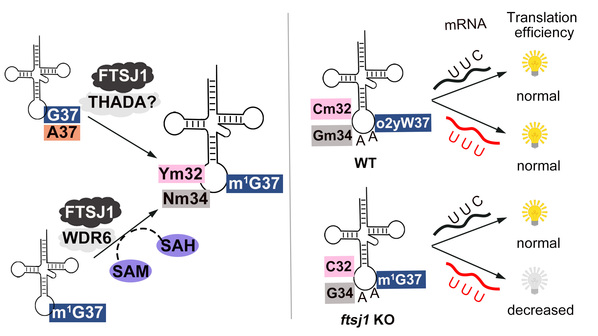On June 18, a research article entitled “Intellectual disability associated gene ftsj1 is responsible for 2'-O-methylation of specific tRNAs” was published online in EMBO Reports. This work was done by Liu Ru-Juan’s group in the School of Life Science and Technology (SLST) at ShanghaiTech University and Wang En-Duo’s group from Shanghai Institute of Biochemistry and Cell Biology.

tRNA modifications are necessary for protein biosynthesis of living organisms, and precisely regulate the non-canonical function of tRNA. Aberrant tRNA modifications could lead to human diseases, and neurological diseases in particular. Up to now, 10 kinds of aberrant tRNA modifications have been reported to be closely related to neurological disorders, such as intellectual disability, microcephaly and epilepsy, suggesting that tRNA modifications are of vital importance in nervous system development. Among them, the mutations of FTSJ1, the gene encoding the putative tRNA modifying enzyme, cause intellectual disability. tRNAPhe from intellectual disability patients with loss-of-function mutations of ftsj1 lacks Cm32, Gm34 and peroxywybutosine (o2yW) 37.
In this study, researchers sucessfully reconstituted the methylation activity of FTSJ1 in vitro, and identify that FTSJ1 is the tRNA: 32 and 34 2'-O-methyltransfearse. They further showed that tRNA substrate recognition of FTSJ1 requires the participation of auxiliary proteins. Meanwhile, they discovered that the modifications in anti-codon loop of tRNAPhe are inter-dependent and occur in a hierarchical order: (i) the formation of Gm34 depends on m1G37; (ii) Cm32 and Gm34 modifications promotes o2yW37 formation from m1G37. The Nm32 and Nm34 modification catalyzed by FTSJ1 is in the center of this modification circuit. They further showed that FTSJ1 regulates the translation efficiency of the UUU codon but not UUC codon (UUU and UUC both encode Phe), thereby affecting the expression of brain/nervous-related genes. Bioinformatics analysis reveal that almost 40% of the high TTT-biased genes (the usage of UUU to UUC in transcripts> 80%) are related to brain/nervous functions. This study provides a new clue towards revealing the relationship between ftsj1 mutations and intellectual disability.
This study was supported by grants from National Key Research and Development Program of China, the Strategic Priority Research Program of the Chinese Academy of Sciences, National Natural Science Foundation of China, Research Start-Up Funds of ShanghaiTech University, and the Youth Innovation Promotion Association.

The working model of FTSJ1
Link: https://www.embopress.org/doi/10.15252/embr.202050095

